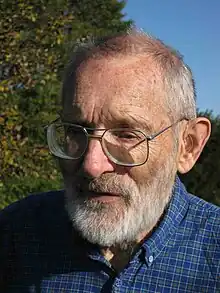Jean Jeener
Jean Louis Charles Jeener was a Belgian physical chemist and physicist, well known for his experimental and theoretical contributions to spin thermodynamics in solids and for his invention of Two-dimensional nuclear magnetic resonance spectroscopy. He was born in Brussels in 1931, son of Raymond Jeener (biologist) and Hélène Massar. He was married to Françoise Henin.
Jean Jeener | |
|---|---|
 Jean Jeener in October 2011 | |
| Born | Jean Louis Charles Jeener July 31, 1931 |
| Died | June 10, 2023 (aged 91) |
| Education | Université Libre de Bruxelles |
| Occupation(s) | Chemist, physicist |
| Spouse | Françoise Henin |
| Awards | Prix Quinquennal Prix Ampère ISMAR Prize Russell Varian Prize Otto Stern Prize |
Early life
Jeener grew up in Brussels.
Career
Jeener was professor in Physics at Université Libre de Bruxelles (ULB) from 1960 until he retired in 1996.
At ULB, Jeener researched spin thermodynamics and spin dynamics in solids. He introduced the “Jeener-Broekaert sequence” for creating observable quantities of dipolar order in solids.[1]
Nuclear magnetic resonance spectroscopy
Jeener is best known for introducing two-dimensional NMR spectroscopy (2DNMR). In a lecture at the AMPERE Summer School in Basko Polje, Yugoslavia, September 1971,[2][3] he proposed a novel technique, later known as Correlation Spectroscopy (COSY), in which the response of the nuclear spins to two radio frequency pulses is treated by a double Fourier transformation with respect to the delay between the pulses, and the delay after the second pulse. This technique gives detailed information about the molecular links between atoms, inaccessible with previous techniques.
The first experimental demonstration of this technique was carried out by Richard R. Ernst (Nobel prize 1991).[4]
Later, Jeener introduced a variant of 2DNMR, today known as Nuclear Overhauser Effect Spectroscopy (NOESY), that gives detailed information about the spin-lattice relaxation matrix, and about the spatial relation between atoms in complex molecules.[5]
2DNMR and its multi-dimensional extensions reveal so much more information about the chemical and physical environment of the spins that they have since been used in almost all fields of NMR. Among other applications, they enable detailed reconstruction of the 3-dimensional structure of complex biological macro molecules.
Recognition
Jeener is recipient of several distinctions, including the Prix Quinquennal of the Fonds National de la Recherche Scientifique (Prix Dr. A. De Leeuw-Damry-Bourlart), the Prix Ampère, the ISMAR Prize,[6] the Russell Varian Prize,[7] the Otto Stern Prize.[8] He is Doctor Honoris Causa of ETH-Zürich. The Jean Jeener NMR Centre, inaugurated in 2010 at the Vrije Universiteit Brussel, is named after him.[9]
Selected journal publications
- J. Jeener; P. Broekaert (1967). "Nuclear Magnetic Resonance in Solids : Thermodynamic Effects of a Pair of rf Pulses". Phys. Rev. 157 (2): 232–240. Bibcode:1967PhRv..157..232J. doi:10.1103/PhysRev.157.232.
- J. Jeener; B.H. Meier; P. Bachmann; R.R. Ernst (1979). "Investigation of exchange processes by two-dimensional NMR Spectroscopy". J. Chem. Phys. 71 (11): 4546–4553. Bibcode:1979JChPh..71.4546J. doi:10.1063/1.438208.
- J. Jeener; A. Vlassenbroek; P. Broekaert (1995). "Unified Derivation of the Dipolar Field and Relaxation Terms in the Bloch-Redfield Equations of Liquid NMR". J. Chem. Phys. 103 (4): 1309–1332. Bibcode:1995JChPh.103.1309J. doi:10.1063/1.469808.
Bibliography
- Jeener, Jean (15 March 2007). "Reminiscences about the Early Days of 2D NMR". Encyclopedia of Magnetic Resonance. John Wiley & Sons, Ltd. doi:10.1002/9780470034590.emrhp0087.
References
- J. Jeener and P. Broekaert, Nuclear Magnetic Resonance in Solids : Thermodynamic Effects of a Pair of rf Pulses, Phys. Rev. 157, 232-240 (1967).
- "Lecture notes from Ampere Summer School in Basko Polje, Yugoslavia, September, 1971", later reprinted in NMR and More in Honour of Anatole Abragam, Eds. M. Goldman and M. Porneuf, Les editions de physique, Avenue du Hoggar, Zone Industrielle de Courtaboeuf, France (1994).
- Richard R. Ernst - Autobiography available at Nobelprize.org
- W. P. Aue, E. Bartholdi, and R. R. Ernst, Two-dimensional spectroscopy. Application to nuclear magnetic resonance, J. Chem. Phys. Vol. 64, 1 (1976)
- J. Jeener, B. H. Meier, P. Bachmann, and R. R. Ernst, Investigation of exchange processes by two‐dimensional NMR spectroscopy, J. Chem. Phys. 71, 4546 (1979)
- ISMAR Prize 2001 Archived 2012-01-17 at the Wayback Machine. International Society for Magnetic Resonance.
- Russell Varian Prize 2002 Archived 2012-03-30 at the Wayback Machine. Euromar.org.
- Otto-Stern-Preis der GDCh-Fachgruppe Magnetische Resonanz.
- The Jean Jeener NMR Centre Archived 2012-03-30 at the Wayback Machine. Vrije Universiteit Brussel.